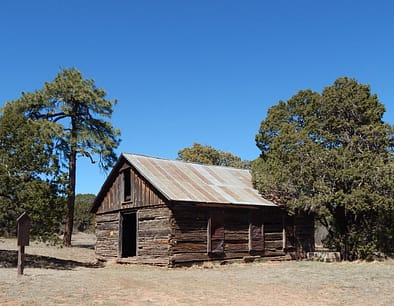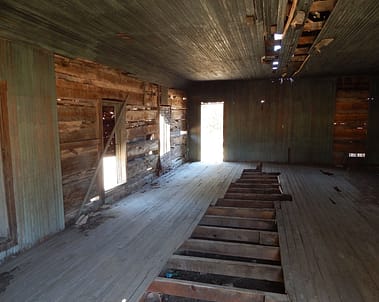Classic One-Room Schoolhouse Still Stands in Jicarilla
The Jicarilla schoolhouse was placed on the New Mexico State Register of Cultural Properties in 1977 and the National Register of Historic Places in 1983. Betsy Swanson of the New Mexico Historic Preservation Bureau wrote the national nomination and recommended inclusion based on significance in architectural, education and exploration/settlement.

According to Swanson, the schoolhouse is one of the best examples of pioneer architecture in the area.
Built in 1907, the school was constructed of Ponderosa pine logs hauled down from Ancho Peak and milled at a nearby sawmill. The logs were squared with dovetail joints and chinked with mud and wood strips. Phillip Reasoner, Sr. was a local carpenter and did much of the interior work.
The building consists of one large rectangular room. One end had a double door; the other end a single door. There are three windows on each side that at one time consisted of double-hung and double-paned sashes. The windows are now covered with tin from the old roofing and the doors are missing. Floorboards made of milled lumber are also missing and some of the original tongue-and groove beaded boards that covered the walls are severely damaged.
The inside was painted light blue. There is the remainder of a stove pipe in the middle of the ceiling and a cistern outside, remnants of the rudimentary ways of life.
The schoolhouse is located between White Oaks and Ancho on a dirt road in the Lincoln National Forest that was once the main route from Ft. Stanton to Santa Fe. It was the pride of the community, also functioning as a church on Sundays, a dance hall on Saturday nights and a gathering place for the annual Fourth of July picnic. When a new school was built in the 1930s, the log schoolhouse continued to house church services until it was finally abandoned. Ironically, the Great Depression brought many more people to the area to eke out a living by mining for gold. As many as 300 people lived in the Jicarilla Mountains, but when the economy improved, the area experienced a downturn as people moved away. By 1942, most families had left and the post office closed. A few families continue to live in the area and Jicarilla gained some notoriety in 2003 when a miner living in the area battled the Forest Service over his occupation of the once general store, judged to be on Forest Service land.
A few buildings still exist in the community and the schoolhouse stands as a testament to the importance of education at the turn of the century. Swanson quotes Mrs. Wallace L. Gum
m, the superintendent of Lincoln County schools in 1913 as writing that log schoolhouses were being replaced by “good modern school-houses” and Ralph E. Twitchell wrote that “The day of the log school houses is past,” and, yet, the Jicarilla schoolhouse was deemed worthy of preservation over 66 years later.
